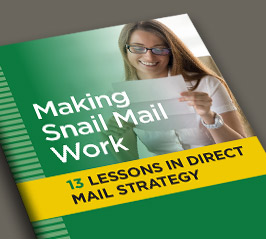
Direct Mail Postage Rates
McCarthy & King Marketing is a Massachusetts direct marketing agency that provides strategically focused direct mail marketing programs for businesses and non-profits. On this page, we focus on issues related to postage rates.
Postage rates – a critical piece of the puzzle
Postage rates are a big part of your direct mail campaign. Depending the rate you choose and the package you’re sending, it could be as much as 50% or more of your cost.
For most us, postage is a fact of life – something we’re stuck with – but not something we spend much time thinking about.
If you ever have taken a look at a postal rate chart, you will likely throw it down in frustration. And even if you do start to understand that chart, wait a few minutes because it’s going to change again.
Still as direct marketers, we need to be aware of postage rules and rates so that we do not create mailers that will unnecessarily increase costs – or worse, won’t get delivered.

First Class Postage
We’re all familiar with first class postage. Whenever we send an individual piece of mail, we put a First Class stamp on the envelope and drop it in the mail.
It’s the same with direct mail campaigns although the quantities are usually higher and postage may be presented as a printed indicia instead of a stamp.
First Class mail is often delivered in just two or three days and when a piece of mail cannot be delivered, it is usually returned to the sender at no cost.
First Class mail is already more expensive than other types of direct mail, but there are other rules that can make it even more expensive.
For example, the base rate applies for mailers up to one ounce. (One ounce gives you an outer envelope and two inserts – a letter and reply card. Add a third insert and you are close to going over one ounce.) Higher than one ounce and you’ll pay even more.
Standard Class Postage
Standard Class postage is also known as bulk mail or Third Class mail. (Third Class was officially replaced by Standard Class, but I still use Third Class because it’s more descriptive.)
Standard Class mail is most commonly used for commercial direct mail campaigns. It’s slower than First Class (it could take a week or two for delivery), but it’s about 25% cheaper.
It also has more flexibility in how many components your mailer can have. The Standard Class postage rate remains the same up to 3.5 ounces. This would mean your mailer could include multiple elements including a letter, reply card and brochure.
There is an additional cost for packages that exceed 3.5 ounces, but this seldom occurs.
Non-Profit Postage
A special Non-Profit rate has been established for charitites and other non-profit organizations. Separate rates for First Class and Standard Class do not not exist for Non-Profits.
Non-Profit postage rates are siginficantly lower than commercial rates. To qualify for Non-Profit postage, you will need to file with the Post Office.
Format Options
Postage can dictate your choice of direct mail formats and sizes
Letter Rates
Letter rates apply to the most common form of mail – regardless of whether you’re using an Letter/Envelope package or a Self-Mailer. Letter rates apply to size of the mailer, not the type.
Letter rates range from 5×3.5 inches up to 11.5×6-1/8 inches.
Letters must also be horizontally rectangular in shape (the width is longer than the height). Check the post office for required aspect ratio.
Flat Rates
Flat rates apply to those mailers that do no meet the Letter rate specifications
Postcard Rates
Postcard Rates apply to postcards of a particular size – from 3×5 inches up to 4.25×6.
Larger postcards will fall into the Letter or Flat rate depending on the size.
Postcards that meet the required size can be mailed First Class at a rate that is lower than Standard Class – and there’s no minimum or presorting required.
Discounts
For both first class and standard class mail, postage discounts are available if you meet certain requirements designed to save the post office time in handling the mail.
While everyone is eligible for these discounts, from a practical standpoint, you will need a mail house that has the necessary equipment and technology.
Presorts
By presorting your mail before it gets to the post office,
Barcoding
By barcoding your mai before it gets to the post office.
Post Office Delivery
By delivering your mail directly to the target post office or distribution center
Mailing Density
By mailing a minimum quantity to specific codes or regional zip areas
Get started or learn more
So what’s your next step? If you’re close to making a move, we’d love to talk. Call Bob McCarthy at 508-473-8643 or send him an email at bob@mccarthyandking.com.
If you’re not there yet, let’s stay in touch. Please join our mailing list and get all of our updates and articles.
Of course, if you have any questions, please don’t hesitate to call.
If you’d like to discuss an upcoming campaign – or if you’re looking for ways to improve an existing mailing program – call us and let’s schedule an introductory call.
